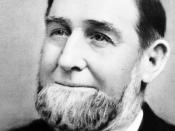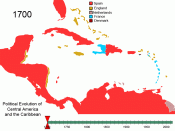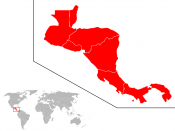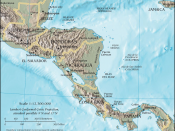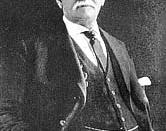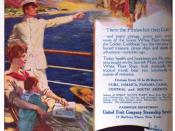The Banana DictatorIn allusion to the nineties iconic pop artist Gwen Stefani, "this shit is bananas, B-A-N-A-N-A-S!" and in Central America these catchy lyrics certainly hold true. In the early and mid twentieth century the Central American government and economy were going bananas for the United Fruit Company, Central America's largest foreign investor. North America's United Fruit Company (UFCO) was an industry almost entirely devoted to the export of Central American gold: also known as bananas. Bananas became a prized commodity in many countries within Central America namely: Honduras, Guatemala, and El Salvador. UFCO was the primo leader of produce after the First World War because of the United States dominance in transportation, economy, and governmental influence. The profits, employment, and development generated by banana production of companies like UFCO were very vital to the Central American economies. In countries where jobs were sparse and foreign debts were huge, the economic benefits were greatly needed.
The potential revenue from bananas was so dreamy that many Central American governments tried extremely hard to attract fruit companies. The development and reliance on this industry led to a revolution of the economic, political, and social landscape of the region.
Central America during the early and mid twentieth century was not unified at all and during this time period Liberal dictators began to take control and develop their states. The first priority of these new Liberal dictators was to install railroads for fast express and large capacity transportation to gain economic dominance and power over another nearby country during this time of political unrest. In Central America's competition quest to further their trade and economy railways were a necessity, however; it takes great wealth to fund such an extensive project, wealth Central American nations did not possess. The railways already produced in Central America were made possible by giant foreign funds by the British or Germans before the United States came to dominate later. This was the exact case in Guatemala when Justo Rufino Barrios' "plans for a railway to the north coast [of Guatemala] were not successful. As with most of the rest of Central America, that region had to wait until a giant foreign firm, the United Fruit Company, did the job in the twentieth century." (Woodward: 161) The UFCO became the enabler of many impressive advancements in Central America, transportation being a focal point. In 1871, railroad entrepreneur Henry Meiggs from New York, signed a contract with the government of Costa Rica to build a railway linking the city of San José to the Caribbean port in Limón. Minor Cooper Keith assisted his uncle Meiggs as a young man during the project and eventually took over the business after Meiggs' death in 1877.
Banana trade took off when it proved to be profitable for the railroad systems in 1878 when Minor Cooper Keith began shipping small amounts of bananas to New Orleans from Limón. From this point on, the government supported the export of bananas by instilling export-tax exemptions, to encourage more trade to increase the economy to fund railroad endeavors. In 1885, Costa Rica exported over a half a million bunches a year and the potential of this profit producing produce could truly be seen, from then on the export of bananas escalated quickly. "The banana economy is almost entirely export oriented. Approximately 85% of the fruit grown Central America is exported to industrialized countries." (Thomson: 84). The founder of Tropical Trading and Transport, Minor Cooper Keith, had much success in the banana business and he developed a large trade linking Costa Rica with the United States. Keith married Cristina Castro Ferández, the daughter of the President of Costa Rica, José MarÃÂa Castro Madriz, and became known as the `Uncrowned King of Central America'. His success in the industry didn't go unnoticed. Many small independent growers popped up around Central America, the most competitive being the Boston Fruit Company started by Lorenzo Baker in 1870 when he shipped bananas from Jamaica to Boston. The in 1899 the two most predominant companies merged to form the United Fruit Company. The combination of the two big timers became one of North America's monster conglomerates. The UFCO pealed into Central America's banana of gold and fed the fruit to the very hungry new foreign investors.
The government started by supporting and encouraging banana trade in the early 1870's because of their ability to perform as a catalyst for railroad construction and land development. As soon as banana manufacturing took hold the multimillion dollar company, UFCO, started building railroads throughout Central America to increase their profits. The UFCO's interest in building railways grew and they spread to the Caribbean and Pacific coasts. Meanwhile major railroads were completed with Guatemala's transcontinental railway in 1908, and railroads in Panama, Nicaragua, El Salvador, and Honduras. Honduras became the highest banana producing country in Central America where bananas were their primary export. Honduras revolved around banana production; the major railways only serviced banana trade routes and did not even reach past San Pedro Sula. The North American investors took immediate interest in Honduras' trade where it became a primary source of bananas for UFCO. As the UFCO became more and more predominant in Central America they simultaneously gained control of the railroads through their International Railways of Central America (IRCA). Not only did the UFCO have railways as means of transportation but they also had steamships that connected the United States with Central America known as "The Great White Fleet". By 1930 the United Fruit Company had a total of ninety-five vessels, some owned and rented. The UFCO was the only corporation that could afford ships and they took over the ports from Limón in the Caribbean to Puerto Barrios, Guatemala because they were the only ones that frequented the ports.
The United Fruit Company established itself as the foremost economic interest in Central America by owning large amounts of land and having extensive means of transportation to areas far and wide. Because it was the leading economic interest the government sought to keep the UFCO in "an ideal investment climate". To keep UFCO happy they received the best and largest pieces of government concession land at little to no cost, low export taxes, and immunity from labor and environmental laws. The competition over land concessions was intense especially with other small companies and with UFCO's largest competitor, the Standard Fruit Company and Steamship Company and Cuyamel Fruit Company, in 1924. Together these companies expanded the export and market of bananas by working together. The good relations among the companies came to an end when UFCO and Cuyamel came into close competition over prized land concessions. Honduras was the chief banana producer and therefore the most desirable land concession, to win this concession the companies would even go as far as to fund revolutions in Nicaragua and Honduras. The United Fruit Company was nicknamed "El Pulpo" (the octopus) because they were so eager to get involved in politics, sometimes even violently. In 1910, Sam Zemurray, hired a group of armed assassins from New Orleans to help stage a coup in Honduras to beat out UFCO in the competition over government concessions for his own banana-trading company, Cuyamel Fruit. The dispute finally ended in a compromise when UFCO bought out Cuyamel but then a few months later its previous president became the chairman of UFCO's board. The government also granted the UFCO with large amounts of concession lands because they really wanted economic development, and use of railroads and shipping ports.
With the large amounts of land in lowly populated areas of the hot coastal plains where no one wanted to work, the UFCO imported Blacks from Jamaica and the Caribbean to work as a labor force on plantations, railroads and shipping yards. When the foreigners imported Blacks it greatly changed the racial concentration of Central America and created immense racial tension in society. However, the Blacks were not accustomed to the germs in the hot coastal plains and they quickly began to die off because of disease. Once Panama disease broke out among the workers and in 1935 when the bananas became infected with Sigatoka it became essential to find a solution to these diseases to ensure the safety of the company's growth. The United Fruit Company took extreme measures to help rid Central America of the Panama disease, yellow fever, malaria, and other illnesses by opening clinics and vaccination departments. Disease was a huge obstacle that Central America could not have overcome by itself but with the help of the UFCO resources disease was decreased with large investments in research and insecticide. Among medical advancements the UFCO also expanded its activities to making communication for efficient between the US and Central America. This was beneficial to mainly the UFCO but also the Central American states. The first radio communication started in 1910 and by 1913 the Tropical Radio Telegraph Company was formed. UFCO also helped accomplish many of the Liberals goals for economy and resource growth, however; these accomplishments were at the sacrifice of economic and political independence of Central America. "Among the benefits were development of transportation and ports; valuable foreign exchange, which financed further (if modest) economic development; substantial tax revenues; exploitation of lowland regions; and eradication of deadly diseases endemic to the tropics." (Woodward: 182) The UFCO was working hard to make nice with Central America because the natives did not hold fond memories of them. For the Central American people the UFCO did indeed bring these benefits but at the cost of their own political and economical freedom.
Central Americans watched as U.S. foreign investors reigned over their country flexing their muscles and dipping into all the benefits of Central America they could. The native people were only allowed the leftover land that the UFCO or government did not already possess and that they could afford to purchase (which was a feat in itself), and with the small land they had they could not produce enough income to even come close to that of "El Pulpo." The UFCO was the largest manufacturer of bananas in Central America by far and it controlled its own marketing and production, but that was not enough, they also bought from smaller autonomous growers. Because the UFCO produced the most bananas and was the only real exporter to customers, small agricultural businesses had no choice but to sell their produce to UFCO because there was no one else to sell too. The UFCO controlled the market of bananas and therefore controlled the price as well, thus giving small businesses no choice but to sell to them and at the price the UFCO decided on. The UFCO was effectively a monopoly over all Central American produce. It was easy for this foreign-controlled entity to make all the rules to benefit itself because by 1950 the United States of America consumed just about fifty percent of the world's banana exports. "The United States is the largest banana consumer, importing an average of 3.7 million tons of the fruit each year." (Baxter: 62) Thus the US secured its position as the most important economic interest and subsequently the most important interest in the political scene. The native people were thus left with little or no economical or political power.
As the United States poured more and more time and capital into Central America, competition between other foreign investors became intense. "By the twentieth century there were British, German, Dutch, North American, French, and Middle Eastern merchants operating in Central America in large numbers." (Woodward: 183) The contest was mainly between the previous primary foreign controllers, Great Britain and Germany, and the new power, the United States of America. Before World War I Great Britain and Germany were the leaders of Central American economic interest but after the war they were left with other major issues at hand. Their ships were called out for war rather than for trade, and their heads turned to more imminent problems on the home front. When the North American corporation of the United Fruit Company became the dominant economic interest in Central America it started to phase out the previous interests which caused great tension. The United States has great advantages over Britain and Germany because they were closer to Central America but the Europeans maintained to be a formidable competitor because they had been established earlier in Central America. The British owned the monopolies on tobacco and alcohol, previously owned by the state, primarily in Nicaragua making it a major influence. The British also started early building much of the initial railroads but they were later overtaken by the dominance of the United States. The British Pacific Mail Steamship Navigation Company dominated the Pacific coast shipping but was replaced again by the UFCO. Germany too had an early start. They had been involved with the coffee industry and made large profits from it with the aid of their brilliant engineering and shipping. However, when the depression of the 1920's struck coffee sales plummeted, severely hurting the German markets. The Germans were also pushed out of the running for foreign economic domination when the German Kosmos Line of ships left because they were needed for World War I. The United States sealed the deal again with the better capitalized foreign corporation that started in Honduras, the main producer of bananas, Pan American Airways which became one of the most important operations in Central America. From the early to mid 1900's the Central American commerce with the United States more than doubled that of its European competitors.
With all of the transportation in Central America formed by large foreign investments, the transportation mainly served only the foreign investors. It was all foreign control of internal transportation in Central America, this made it very difficult to further and improve national integration. The only two countries connected by a railway were Guatemala and El Salvador which was really because it was built for a trading route. It was very difficult to get service from one Central American country to another because all of the major transportation led from one Central American country out to deep sea ports or to the United States not to another nearby country. "Government owned or subsidized steamers sometimes provided such service, but the foreign companies were reluctant to promote this apparently unprofitable traffic. Thus, modern transportation improvements, which might have brought the states closer together, instead seemed to emphasize their separateness." (Woodward: 185)Central America at first glance would appear to be making serious bank from all of the banana market and exports but really "only 11.5% of the total value of bananas generated at the retail level accrues as retained value to the national economies which support them". The remaining 88.5% accrues to foreign enterprises such as transnational, wholesalers, and retailers, owned and operated by citizens of importing countries." (Thomson: 88) The expansion of the banana industry develops rapidly but is also followed by rapid economic decline of the Central American country once banana production goes down. Banana production decreased for many reasons (disease, natural disasters, political unrest, and changing markets) and resulted in a number of counties in Central America being completely deserted by the banana industry. These countries were completely dependent on banana production and thus faced severe economic depression. In the 1930's Costa Rica was a major Pacific sea port for banana exports but in 1956 when disease struck the area the port was abandoned. Costa Rica plummeted into an economic depression and to make matters worse it also suffered a decrease in population due to disease and those who fled the sickness and depression. (Hall: 35) Costa Rica is not the only country to befall this; this became a pattern for banana companies. When the land was poisoned by disease or ruined by storms or poor markets, the company left for a more profitable area. The banana industry exploited the Central American countries and left them with little resources or economic and political power. The different Central American governments had done almost anything to draw in banana industries because they increased export revenues, employment, and development in hope of becoming more independent and developed but in the end it only gave away the great economic and political power to foreign investors. The United Fruit Company still exists to this day and after it merged with Eli M. Black's AMK conglomerate in 1970 to become the United Brands Company. Then in 1984, under Carl Lindner Jr. it became known as today's very popular fruit company Chiquita Brands International.
BibliographyAstorga, Y. 1998. The Environmental Impact of the Banana Industry.
Baxter, Terry. 1998. The Hidden Life of Bananas. Sierra.( 5) 62 - 63.
Ferguson, James. 1998. A Case of Bananas. Geographical. 520(1) 49 - 52.
Hall, C. 1985. Costa Rica: A geographical Interpretation in Historical Perspective. Boulder, CO and London: Westview Press.
Kepner, C. D. 1967. Social Aspects of the Banana Industry. New York: AMS Press, Inc.
Norsworthy, K. and T. Barry. 1993. Inside Honduras. Albuquerque, NM: The Inter-Hemispheric Education Resource Center.
Thomson, R. 1987. Green Gold. London: Latin America Bureau Limited.
Woodward, Ralph L. Central America, A Nation Divided. Third ed. New York, NY: Oxford UP, 1999. 161-189.
Wrigley, G. 1969. Tropical Agriculture. New York and Washington: Frederick A. Praeger.
